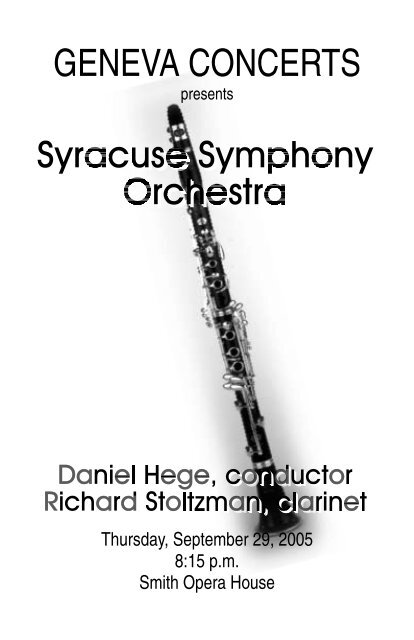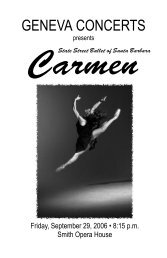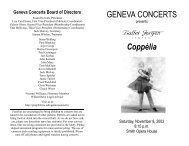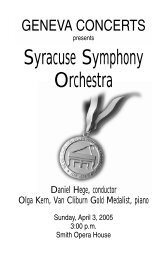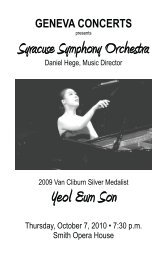GENEVA CONCERTS
SSO Hege Stoltzman program for web - Geneva Concerts
SSO Hege Stoltzman program for web - Geneva Concerts
- No tags were found...
You also want an ePaper? Increase the reach of your titles
YUMPU automatically turns print PDFs into web optimized ePapers that Google loves.
<strong>GENEVA</strong> <strong>CONCERTS</strong><br />
presents<br />
Thursday, September 29, 2005<br />
8:15 p.m.<br />
Smith Opera House
<strong>GENEVA</strong> <strong>CONCERTS</strong>, INC.<br />
2005-2006 SEASON<br />
Thursday, 29 September 2005, 8:15 p.m.<br />
Syracuse Symphony Orchestra<br />
Daniel Hege, conductor<br />
Richard Stoltzman, clarinet<br />
Ellington, Copland, Piazzolla, and Stravinsky<br />
Saturday, 22 October 2005, 8:15 p.m.<br />
Garth Fagan Dance<br />
Sunday, 13 November 2005, 3:00 p.m.*<br />
Masters of Caribbean Music<br />
The Mighty Sparrow<br />
Ecos de Borinquén<br />
Ti-Coca and Wanga-Nègès<br />
Sunday, 5 March 2006, 3:00 p.m.<br />
Syracuse Symphony Orchestra<br />
Daniel Hege, conductor<br />
Sarah Chang, violin<br />
Higdon, Brahms, Bartók<br />
Sunday, 9 April 2006, 8:15 p.m.<br />
Syracuse Symphony Orchestra<br />
Daniel Hege, conductor<br />
Deborah Coble, flute<br />
All-Mozart<br />
Performed at the Smith Opera House, 82 Seneca Street, Geneva, NY<br />
except * Performed at Geneva High School, 101 Carter Road, Geneva<br />
These concerts are made possible, in part, with public funds from the<br />
New York State Council on the Arts, a state agency, and by a<br />
continuing subscription from Hobart and William Smith Colleges.
<strong>GENEVA</strong> <strong>CONCERTS</strong>, INC.<br />
Thursday, September 29, 2005<br />
8:15 p.m.<br />
Syracuse Symphony Orchestra<br />
Daniel Hege, music director<br />
Richard Stoltzman, clarinet<br />
EDWARD KENNEDY “DUKE”<br />
ELLINGTON<br />
Black, Brown, & Beige<br />
Work Song<br />
1899-1974 Come Sunday<br />
ORCH. ADAPTATION BY JEFF TYZIK Light<br />
AARON COPLAND<br />
Concerto for Clarinet and Orchestra<br />
1900-1990 Slowly and expressively –<br />
Cadenza – Rather Fast<br />
ASTOR PIAZZOLLA<br />
1921-1992<br />
ASTOR PIAZZOLLA<br />
Contemplación y danza<br />
Milonga en re<br />
Richard Stoltzman, clarinet<br />
INTERMISSION<br />
IGOR STRAVINSKY<br />
Pétrouchka (1947 Revision)<br />
1882-1971 The Shrovetide Fair<br />
Pétrouchka’s Cell<br />
The Moor’s Cell<br />
The Fair (towards evening)<br />
Patrons are requested to silence signal watches, pagers and cell phones.<br />
The use of recording equipment is prohibited by law.
Photo by J. Pearson<br />
Richard Stoltzman<br />
has defied categorization, performing as<br />
an orchestral soloist, recitalist, chamber<br />
ensemble member, and jazz innovator.<br />
A graduate of Ohio State University<br />
with a double major in music and<br />
mathematics, Mr. Stoltzman earned his<br />
Master of Music degree at Yale University,<br />
studying with Keith Wilson, and<br />
pursued doctoral studies with Kalmen<br />
Opperman at Columbia University. He<br />
participated in the Marlboro Music Festival<br />
for ten years and became a founding member of the ensemble<br />
TASHI.<br />
Mr. Stoltzman performed the first clarinet recitals in the histories<br />
of the Hollywood Bowl and Carnegie Hall. In 1986, he<br />
was the first wind player to win the Avery Fisher Prize. As a<br />
jazz artist, he has performed or recorded with Gary Burton, Judy<br />
Collins, Keith Jarrett, Wayne Shorter, Mel Tormé, and others.<br />
He has premiered works by Stephen Hartke and Einojuhani<br />
Rautavaara (the latter was premiered in 2002 with the National<br />
Symphony Orchestra at the Kennedy Center and Carnegie Hall).<br />
He has more than 50 releases on BMG/RCA, SONY Classical,<br />
MMC, BIS, Albany, Ondine, and other labels, including two<br />
Grammy winners: Brahms Sonatas with Richard Goode, and<br />
Trios of Beethoven, Brahms, and Mozart with Emanuel Ax and<br />
Yo-Yo Ma. He released a recording of the Rautavaara Concerto<br />
in 2005.<br />
Recitals and chamber music performances include appearances<br />
with violinist/wife Lucy Stoltzman and pianist/son Peter<br />
John Stoltzman. In 2003 the Stoltzman family, called “New<br />
England’s First Family of Classical Music” by WGBH radio in<br />
Boston, appeared at Kennedy Center in a program of jazz and<br />
classics.<br />
Richard Stoltzman is also a Cordon Bleu-trained pastry chef.
Daniel Hege<br />
Now in his sixth season as Music<br />
Director of the Syracuse Symphony<br />
Orchestra, Daniel Hege is widely<br />
recognized as one of America's finest<br />
young conductors, earning critical<br />
acclaim for his fresh interpretations of<br />
the standard repertoire and for his<br />
commitment to creative programming.<br />
Mr. Hege was named Music Director<br />
of the Syracuse Symphony Orchestra in<br />
April 1999. In 2001, he finished a six-year tenure with the Baltimore<br />
Symphony Orchestra, where he held the titles of Assistant,<br />
Associate, and Resident Conductor. His previous positions include<br />
Music Director of the Newton Mid-Kansas Symphony Orchestra,<br />
Music Director of the Haddonfield Symphony (New Jersey), Associate<br />
Conductor of the Kansas City Symphony, Music Director of<br />
the Encore Chamber Orchestra in Chicago, and Music Director of<br />
the Chicago Youth Symphony Orchestra, where he was twice honored<br />
by the American Symphony Orchestra League for innovative<br />
programming.<br />
In 1990 Mr. Hege won a national conducting competition and<br />
became Music Director of the Young Musicians Foundation<br />
(YMF) Debut Orchestra in Los Angeles. He was later appointed<br />
Assistant Conductor of the Pacific Symphony. A strong advocate<br />
for arts education, he served as Director of Instrumental Music for<br />
the Orange County High School of the Arts for two years, beginning<br />
in 1991. He was also Principal Conductor of Disney’s Young<br />
Musicians Symphony Orchestra, working with such artists as<br />
Henry Mancini, John Williams, Branford Marsalis, Doc Severinsen,<br />
and Dudley Moore, and leading concerts televised nationally<br />
by the Disney Channel to more than 50 million viewers.<br />
Mr. Hege’s guest conducting engagements include the Annapolis,<br />
Baltimore, Charlotte, Colorado, Colorado Springs, Detroit,<br />
Eugene (OR), Houston, Indianapolis, Kalamazoo, Kansas City,<br />
North Carolina, Oregon, Phoenix, San Antonio, San Diego, Seattle,<br />
Singapore, St. Petersburg (Russia), and Wichita symphony orches-
tras; the Calgary, Dayton, Naples (FL), and Rochester philharmonic<br />
orchestras; the Civic Orchestra of Chicago; the Auckland<br />
(New Zealand) Philharmonia; the Symphony Orchestra of Lima,<br />
Peru; and the Aspen and Grand Teton music festivals, and Syracuse<br />
Opera.<br />
Under the artistic leadership of Mr. Hege, the Syracuse<br />
Symphony Orchestra performed in Carnegie Hall in April 2003,<br />
and released its first recordings in over 20 years: a live Classics<br />
Concert CD released in 2000, and the SSO’s latest release, Holiday<br />
Pops. Mr. Hege recorded a disc of works by Adolphus Hailstork<br />
with the Baltimore Symphony Orchestra and the Morgan<br />
State University Choir; a CD on the Cedille label, which was<br />
nominated for a 1998 NPR Heritage Award, Violin Concertos<br />
by Black Composers of the 18th and 19th Centuries, with the<br />
Encore Chamber Orchestra of Chicago; and The Gift, a collection<br />
of Christmas arrangements on Woodland Records, with<br />
oboist Brad Smith.<br />
Mr. Hege studied with noted conductor and teacher Daniel<br />
Lewis of the University of Southern California, and was a conducting<br />
student of Paul Vermel at the Aspen Music Festival. In<br />
May 2004 he received an honorary doctorate in Humane Letters<br />
from LeMoyne College. Daniel Hege resides in Jamesville, New<br />
York, with his wife Katarina and their two daughters.
Program Notes<br />
EDWARD KENNEDY “DUKE” ELLINGTON<br />
b. Washington, D.C., April 29, 1899<br />
d. New York, NY, May 24, 1974<br />
Black, Brown, and Beige<br />
The short course…<br />
· Composed in 1943, Black, Brown, and Beige premiered at Carnegie Hall<br />
on January 23, 1943 to mixed reviews. Critics didn’t take the work seriously<br />
until 1958, when Ellington recorded a version featuring gospel<br />
vocalist Mahalia Jackson.<br />
· This is the SSO’s first performance of Black, Brown, and Beige.<br />
The name Duke Ellington conjures an image of irresistible tunes<br />
making the rounds along the nightclub scene in pre-Swing Era Harlem,<br />
with catchy titles such as Mood Indigo and Jubilee Stomp. Yet Ellington,<br />
celebrated throughout his career as a composer, pianist, and bandleader,<br />
also spent considerable energy on a much longer and more serious<br />
endeavor—a large-scale work depicting the history and culture of<br />
African-Americans.<br />
The result of his Herculean effort was Black, Brown, and Beige, or<br />
B, B, & B, as The Duke preferred to call it, completed in 1943 and<br />
which he subtitled “a Tone Parallel to the History of the Negro in<br />
America.” Ellington was so proud of this 50-minute work he took it<br />
along with him to Carnegie Hall (on the “A Train,” no doubt), for his<br />
debut there.<br />
The harmonic language of B, B, & B is the vernacular—jazz, blues<br />
and spirituals. Taken as a whole, the musical structure assumes the dimension<br />
of a tone poem, with colorful, programmatic names attached to<br />
individual movements that illuminate the particular mood he sought to<br />
capture.<br />
For this occasion the SSO will be playing an orchestral arrangement<br />
by the Rochester Philharmonic Orchestra’s pops conductor, Jeff Tyzik,<br />
who re-worked three movements of Ellington’s masterpiece into a 10-<br />
minute long suite comprising the movements “Work Song,” “Come<br />
Sunday,” and “Light.”<br />
Tyzik’s orchestration takes the Duke Ellington Orchestra version<br />
and kicks it up a notch—expanding the instrumentation into symphonic<br />
proportions and spicing up the harmonic colors to produce a rich elabo-
ation of the original. Still, die-hard Ellington fans will no doubt find<br />
something conspicuously absent from this arrangement—a piano.<br />
“Ellington himself played very little during these performances,”<br />
explains Tyzik, “so I didn’t include one.” No big deal, really; or, as The<br />
Duke would say, “It don’t mean a thing . . .”<br />
- David Abrams<br />
Instrumentation: 2 flutes doubling piccolo, 2 oboes doubling English horn,<br />
2 clarinets and bass clarinet, 2 bassoons, alto saxophone, 4 horns, 3 trumpets,<br />
3 trombones, tuba, timpani, percussion, jazz bass, harp, and strings.<br />
AARON COPLAND<br />
b. Brooklyn, NY, November 14, 1900<br />
d. Westchester, NY, December 2, 1990<br />
Clarinet Concerto<br />
The short course…<br />
· Composed in 1948, this work was premiered in 1950 in New York<br />
City, with Benny Goodman as soloist and Fritz Reiner conducting.<br />
· The SSO last performed Clarinet Concerto in February 2000 with<br />
Fabio Mechetti conducting and Carey Bell as soloist.<br />
Aaron Copland’s Clarinet Concerto seems to me to stand poised on<br />
the balance point between the jazz world and the classic world. In the<br />
cadenza that links the dreamily slow waltz of the first movement to the<br />
fast and syncopated second movement, the composer succeeds in elegantly<br />
transforming the language of the clarinet from western European<br />
chalumeau (the 18 th century forbearer of the clarinet) to sassy North and<br />
South American licorice stick.<br />
How does Copland do this? By opening the concerto with long line<br />
soft legato melodies accompanied by harp, he lulls the listener into a<br />
safe and comfortingly familiar path. Then, as the strings and harp fade<br />
away, Copland begins to add accents, syncopations, and a “twice-asfast”<br />
tempo—like a big band leader counting off quickly, “1…2…,<br />
1 . 2 . , 1 2 3 4.” After introducing motives that will appear in the second<br />
movement, he begins a South American dance rhythm combined<br />
with arpeggiated descending chords à la the King of Swing. After all,<br />
Copland wrote this music for the quintessential American clarinetist,<br />
Benny Goodman.<br />
As a kid, seeing The Benny Goodman Story (starring Steve Allen), I<br />
became convinced that I was playing the right instrument. Little did I
know then that I would have the good fortune to visit with Benny at his<br />
New York penthouse, “jam” on Italian clarinet duets with him, and be<br />
honored by his attendance at my first Carnegie Hall recital! Of course,<br />
the ultimate thrill for me was to play this great landmark concerto for<br />
Copland at his 75 th birthday celebration in Carnegie Hall with André<br />
Previn and the Pittsburgh Symphony Orchestra.<br />
- Richard Stoltzman<br />
Instrumentation: harp, piano, and strings.<br />
ASTOR PIAZZOLLA<br />
b. Mar del Plata, Argentina, March 11, 1921<br />
d. Buenos Aires, Argentina, July 4, 1992<br />
Contemplación y Danza and Milonga en re<br />
The short course…<br />
· This is the SSO’s first performance of Contemplación y Danza and<br />
Milonga en re.<br />
Astor Piazzolla’s fame as a composer is linked to the allure of the<br />
Tango—its bold rhythms and unusual instrumental combination, its bittersweet<br />
philosophy, and its formal constraints. In 1950, however, with<br />
Op. 15, Piazzolla explored a different compositional path.<br />
Contemplación y Danza (Contemplation and Dance) employs the<br />
classic instrumental combination of clarinet soloist with string orchestra.<br />
The harmonic language is based on clashing intervals of the fourth<br />
with the soloist contemplating and embellishing the theme.<br />
The dance launched by the strings is wildly fast; and the biting<br />
rhythm is irregular metrically, but totally unified in the orchestra. When<br />
the clarinet leaps in, the strings jump to pizzicati. This dance quickly<br />
comes to an end in a whirling frenzy of dissonant fourths and a wailing<br />
cry from the clarinet.<br />
Milonga en re is a hauntingly, broody Tango whose slow tempo allows<br />
the clarinet and strings to dance with each other with smoldering<br />
passion.<br />
- Richard Stoltzman<br />
Instrumentation: piano, percussion, and strings.
IGOR STRAVINSKY<br />
b. Oranienbaum (now Lomonosov), Russia, June 17, 1882<br />
d. New York, NY, April 6, 1971<br />
Pétrouchka (1947 Revision)<br />
The short course…<br />
· Composed between 1910 and 1911; revised 1946-1947. This work<br />
was premiered in Paris at Le Châtelet, June 13, 1911.<br />
· Stravinsky's score began as a Konzertstück (short, one-movement<br />
concerto) for piano and orchestra, but evolved into a full-length ballet<br />
arranged in four scenes.<br />
· Pétrouchka was last performed by the SSO in October 1999,<br />
conducted by Grant Cooper.<br />
Ambiguity is at the heart of Pétrouchka. Musically, this is reflected<br />
in a C major-F sharp chordal conflict that repeatedly haunts the ear with<br />
its shattering bitonality. Pétrouchka, the Russian Pierrot, stems from the<br />
commedia dell'arte tradition. He, too, loves his Columbine—a pretty<br />
Ballerina—and feels hatred for the menacing Moor, an exotic form of<br />
the Harlequin figure.<br />
Stravinsky’s score began as a Konzertstück (short, one-movement<br />
concerto) for piano and orchestra. In his autobiography he wrote: “I had<br />
a clear picture of a puppet suddenly endowed with life, trying the<br />
patience of the orchestra with a diabolical cascade of arpeggios. The<br />
orchestra responds in turn with threatening trumpet calls. There results<br />
a tremendous brawl which reaches its climax and ends with the sad and<br />
querulous collapse of the poor puppet. Having finished this bizarre<br />
piece I struggled for hours to find a title . . . (then) one day I leapt for<br />
joy. I had found it—Pétrouchka, the immortal and unhappy hero of<br />
every fair in all countries.”<br />
Diaghilev then persuaded Stravinsky to make a full-length ballet<br />
out of the tale of Pétrouchka. Their friendship had been cemented by<br />
the success of Stravinsky's first major ballet score, The Firebird, the<br />
previous year. After Stravinsky became an American citizen in 1945, he<br />
adapted the score for a smaller orchestra so that it could be played more<br />
readily in a normal concert program.<br />
The Ballet is arranged in four scenes. A drum roll leads from one<br />
tableau to the next.<br />
The Shrovetide Fair. From the opening of the first tableau (Admiralty<br />
Square, St. Petersburg, Winter of 1830), the score depicts an energetic,
carefree carnival scene. Strings and lower winds create an aura of<br />
mystery as the Showman introduces himself to the crowd (with a catchy<br />
flute cadenza) before revealing three puppets who, when brought to life,<br />
begin to dance.<br />
Pétrouchka’s Cell. Pétrouchka is shoved into his tiny room by the<br />
callous Showman whose portrait scowls at him from the black<br />
cardboard walls. Trumpet dissonances mirror the puppet's anger at his<br />
predicament. He tries to express his love for the Ballerina, but she is<br />
disgusted by his ungainliness and walks out on him. The dissonant<br />
Pétrouchka trumpet motif lets us know how he feels.<br />
The Moor’s Cell. The Moor’s room is gaudily decorated with palm<br />
trees and exotic fruits. He plays with a coconut (clarinet tune), and the<br />
Ballerina enters, beguiling him to the strains of a waltz. They dance to<br />
what are parodies of romantic pas de deux melodies. Pétrouchka enters<br />
in a jealous rage, and is ejected unceremoniously by the Moor.<br />
The Fair (towards evening). The carnival spirit reaches its height.<br />
Various diversions attract the crowd’s attention: a performing bear, a<br />
drunken merchant, masqueraders, and more. Suddenly a scream is heard<br />
(a muted trumpet crescendo) from within the theater. Pétrouchka rushes<br />
out, chased by the Moor, who cuts him down in full view of the<br />
shocked spectators.<br />
Yet these are merely puppets, the Showman reassures the crowd.<br />
As darkness falls, there are faint tremolos with horns softly muted,<br />
lulling us into a relaxed mood. The dissonant muted trumpet pierces the<br />
silence as Pétrouchka’s spirit shakes its angry fist at its creator who,<br />
terrified, drops the lifeless puppet and scampers away.<br />
- William D. West<br />
Instrumentation consists of 3 flutes doubling piccolo, 2 oboes and<br />
English horn, 3 clarinets doubling bass clarinet, 2 bassoons and<br />
contrabassoon, 4 horns, 3 trumpets, 3 trombones, tuba, timpani, bass<br />
drum, snare drum, tambourine, cymbals, triangle, gong, xylophone,<br />
harp, piano, celeste, and strings.
Syracuse Symphony Orchestra<br />
First Violin<br />
Andrew Zaplatynsky,<br />
Concertmaster<br />
Jeremy Mastrangelo,<br />
Associate Concertmaster<br />
Vladimir Pritsker<br />
Cristina Buciu<br />
Michael Bosetti<br />
Fred Klemperer<br />
Susan Jacobs<br />
D.J. Igelsrud<br />
Heather Fais-Zampino<br />
Daniel Kim<br />
Lucille Teufel<br />
Stephanie Koppeis<br />
Travis Newton<br />
Amelia Christian<br />
Second Violin<br />
Rose MacArthur, Principal<br />
Petia Radneva-Manolova,<br />
Assistant Principal<br />
Fedor Saakov<br />
Anita Gustafson<br />
Janet Masur-Perry<br />
Julianna Methven<br />
Sonya Williams<br />
Sara Mastrangelo<br />
Susan Harbison<br />
Ni Santiago<br />
Viola<br />
Eric Gustafson, Principal—<br />
Mrs. B.G. Sulzle Chair<br />
Cen Wang, Assistant Principal<br />
Kit Dodd<br />
Carol Sasson<br />
Marywynn Kuwashima<br />
Li Li<br />
Judith Manley Dreher<br />
Amy Diefes<br />
Hee Cheong Boo<br />
Cello<br />
Eduard Gulabyan, Principal—<br />
Mrs. L.L. Witherill Chair<br />
Lindsay Groves, Assistant<br />
Principal<br />
Gregory Wood, Assistant Principal<br />
Heidi Hoffman<br />
Walden Bass<br />
George Macero<br />
Jacqueline Wogick<br />
George Teufel<br />
Contrabass<br />
Edward Castilano, Principal<br />
Peter Dean, Assistant Principal<br />
Angel Sicam<br />
Darryl Pugh<br />
Michael Fittipaldi<br />
Flute<br />
Deborah Coble, Principal<br />
Cynthia Decker,<br />
Assistant Principal<br />
Linda Greene (piccolo)<br />
Oboe<br />
Philip MacArthur, Principal<br />
Patricia Sharpe,<br />
Assistant First Chair<br />
Daniel Carno
Clarinet<br />
Allan Kolsky, Principal<br />
Victoria Bullock<br />
John Friedrichs,<br />
Assistant First Chair<br />
(english horn)<br />
Bassoon<br />
Gregory Quick, Principal<br />
David Ross (contrabassoon)<br />
Martha Sholl<br />
Horn<br />
Julia Pilant, Principal—<br />
Nancy and David Ridings Chair<br />
Paul Brown<br />
Julie Bridge,<br />
Associate Principal<br />
Stephen Laifer<br />
Jon Garland<br />
Trumpet<br />
George Coble, Principal—<br />
Robert C. Soderberg Chair<br />
Guy Piddington, II<br />
John Raschella,<br />
Associate Prinipal<br />
Trombone<br />
William Harris, Principal<br />
Douglas Courtright<br />
Jeffrey Gray (bass tronbone)<br />
Tuba<br />
Ed Diefes, Principal<br />
Timpani<br />
Patrick Shrieves, Principal<br />
Percussion<br />
Herbert Flower, Principal<br />
Ernest Muzquiz<br />
Michael Bull<br />
Laurance Luttinger<br />
Harp<br />
Ursula Kwasnicka, Principal—<br />
Flora Mather Hosmer Chair<br />
Librarian<br />
Douglas Courtright<br />
Kit Dodd, Assistant<br />
Personnel Managers<br />
Gregory Quick<br />
Cynthia Decker<br />
Stage Manager<br />
Wayne Milks, Sr.
Geneva Concerts wishes to thank our donors:<br />
Benefactors ($250 or more)<br />
George Abraham<br />
Charles Achilles & Karen Schwengel<br />
Terry Acree<br />
Willard C. & Sharon P. Best<br />
Elizabeth R. Cosad<br />
Pim & Kamill Kovach<br />
John and Lauralee Maas<br />
Ellen & Kevin Mitchell<br />
Maynard & Carol Smith<br />
Clara Splittstoesser<br />
Mr. & Mrs. John A. Tarr<br />
Sally Webster & Susan Bassett<br />
Joanna & Max Whelan<br />
Nozomi Williams<br />
Patrons ($175 or more)<br />
Anita & Sandy Davis<br />
Dorothy & Sam Dickieson<br />
Donald & Rochelle Downing<br />
Harry & Susan Givelber<br />
Nell Glass<br />
Ellen & Paul Grebinger<br />
Ellen & Gil Stoewsand<br />
Dr. & Mrs. Charles F. Wisor<br />
Supporters ($100 or more)<br />
Bill Ahrnsbrak<br />
Carl & Heather Aten<br />
Helen M. Barben<br />
Paul & Joanne Bleakley<br />
Michael & Hilda Collins<br />
David & Judy Curtis<br />
Mr. & Mrs. William Gabrielsen<br />
Walter & Joan Gage<br />
Mr. & Mrs. R.A. Garnish<br />
Richard & Elizabeth Hart<br />
Robert Huff & Jane Donegan<br />
Gordon & Thelma Jones<br />
Pat Krauss<br />
Dr. & Mrs. Verne Marshall<br />
Mary Lou Marx<br />
Supporters, cont’d<br />
David & Martha Matloff<br />
Mr. & Mrs. Howard W. Meyers<br />
John B. Mulvey<br />
Sharon & William Platzer<br />
John D. Robbins<br />
Bonnie & Bob Rochelle<br />
Larry & Virginia Rockwell<br />
Howard & Susan Sabin<br />
Karl & Ti Siebert<br />
Theodore S. Smith, Jr.<br />
Mary & Terry Spittler<br />
Dr. Kenneth & Eva Steadman<br />
Margaret Thomas<br />
Lee & Lisa Van Dusen<br />
The Vaughn Family<br />
Ford & Harriot Weiskittel<br />
Suzanne Young<br />
Friends ($50 or more)<br />
Margene Achilles<br />
Ute Amberg<br />
A.E. Ted Aub & Phillia C. Yi<br />
Robert C. Bair<br />
Don & Virginia Barton<br />
Nancy & Charles Bauder<br />
Robert & Helen Bergamo<br />
Malcolm Bourne<br />
Mrs. R.W. Brand<br />
Jean Bub<br />
John & Midge Burns<br />
Clarence E. Butler<br />
Larry & Judy Campbell<br />
Dr. Richard & Mary F. Collins<br />
Lois T. Copeland<br />
Bob & Margaret Haining Cowles<br />
Jean & Michael Dickson<br />
Roger & Asta Farrand<br />
Josephine Fragnoli<br />
Elmer & Lynda Hartman<br />
Robert & Engelke Heggie<br />
Mr. & Mrs. Dale Heinzman
Geneva Concerts wishes to thank our donors:<br />
Friends, cont’d<br />
Gary & Susan Horvath<br />
Midge & Joel Kerlan<br />
Paul & Midge Kirsch<br />
Claire F. Kremer<br />
Mr. & Mrs. Robert Lamberson<br />
Mary Luckern<br />
Tom & Joan McClure<br />
Daniel & Monika McGowan<br />
Judith & Scott McKinney<br />
Mr. & Mrs. Steven P. Naimoli<br />
Grace G. Parrott<br />
Anne & Dan Quigley<br />
Richard & Inge Robinson<br />
Jeanne & Paul Salisbury<br />
Mr. & Mrs. Clair Schaffner<br />
Mark & Nancy Scher<br />
Ron & Bette Schubert<br />
Tony & Ann Shelton<br />
Larry & Chris Smart<br />
Brenton & Eleanor Stearns<br />
Mr. & Mrs. Frederick M. Toole<br />
Harry J. Touhey<br />
Dr. & Mrs. Saul Towers<br />
Renata Turri<br />
Meredith Waheed<br />
Ann Warner<br />
Donald & Chris Wertman<br />
Mitchell & Aliceann Wilber<br />
Joan Witte<br />
Contributors (up to $50)<br />
Bill & Pam Atwell<br />
John & Reba Ballard<br />
Susan & David Belding<br />
Dan Belliveau<br />
Jane & Irving Bentsen<br />
Ann & Harry Burt<br />
Jack & Shirley Camp<br />
Ella Cripps<br />
Joyce Crupi<br />
Richard & Claire Damaske<br />
Contributors, cont’d<br />
Donna Davenport<br />
Michael & Janice Day<br />
Mabel & Gerry Deal<br />
William & Liz Dean<br />
Phyllis DeVito<br />
Marion Donnelly<br />
Dorothy Dunham<br />
Megan E. Ferrara<br />
Liz Figura<br />
Jay Freer<br />
Frances E. Freligh<br />
Yong & Hei Lee Hang<br />
Jane E. Howland<br />
Barbara A. Huebner<br />
Marjorie Hunt<br />
Dr. & Mrs. Louis Jasper<br />
Erika & Charles King<br />
John & Kate Komara<br />
Edna May Langan<br />
Marie Luffman<br />
Cynthia W. Massey<br />
John & Michaele McGrath<br />
Sheryl Parkhurst<br />
Marion Quigg<br />
Alice Robinson<br />
Mr. & Mrs. Richard T. Schreck<br />
Mrs. Vera Sebek<br />
Betty Sweetland<br />
Paul & Fran Wenderlich<br />
Elizabeth White<br />
Ed Woodams<br />
Sustaining Foundation/Business/<br />
Institution ($250 or more)<br />
Anonymous<br />
Ramada Inn<br />
Wegmans<br />
Supporting Foundation/Business/<br />
Institution ($100 or more)<br />
Printing Center
Geneva Concerts Board of Directors<br />
Paul Grebinger, President<br />
Ford Weiskittel, 1st Vice President (Publicity Coordinator)<br />
Valerie Olson, 2nd Vice-President (Membership Coordinator)<br />
Hilda Collins, co-3rd Vice-President (Performance Coordinator)<br />
John Maas, co-3rd Vice-President (Performance Coordinator)<br />
Jack Mulvey, Secretary<br />
Joanna Whelan, Treasurer<br />
Susan Belding<br />
Dan Belliveau<br />
Larry Campbell<br />
Joyce Crupi<br />
Donna Davenport<br />
Elizabeth Figura<br />
Jay Freer<br />
Susan Horvath<br />
John Komara<br />
Tom McClure<br />
Bonnie Rochelle<br />
Terry Spittler<br />
Chris Wertman<br />
Phillia Yi<br />
Nozomi Williams, Honorary Member<br />
Willard Best, Legal Advisor<br />
Visit us at<br />
www.genevaconcerts.org<br />
Families are encouraged to bring children to concerts but are asked<br />
to be considerate of other patrons. Patrons are asked not to bring<br />
food or drink into the concert hall. As we do not have ushers, please<br />
use discretion upon late entrance. For your convenience, blue recycling<br />
containers are provided in the lobby. Please deposit unwanted programs for<br />
reuse and recycling. The use of cameras and recording equipment is strictly<br />
prohibited. Please turn off cell phones and signal watches during concerts.<br />
Program Layout/Design by Lisa Van Dusen<br />
Program Printing by The Printing Center


